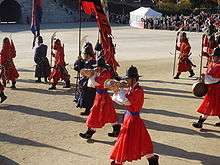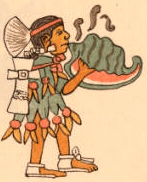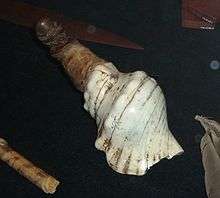Conch (instrument)


Conch, or conque, also known as a "seashell horn" or "shell trumpet", is a musical instrument (often a signal instrument), a wind instrument that is made from a seashell (conch), the shell of several different kinds of very large sea snails. As described by instrument maker Bart Hopkins, such shells are a "gift from the sea that provides a natural conical bore is conch. Conch shell trumpets have been played in many Pacific Island countries, as well as South America and Southern Asia. They produce warm, full, and far-carrying tone."[1]
The shells of large marine gastropods are blown into as if it were a trumpet, as in blowing horn. A completely unmodified conch may be used, or, "a mouth hole is created either by breaking off the point of the shell (for end-blown conches) or by boring a small hole in the body (for side-blown conches). Wooden, bamboo, or even metal mouthpieces may be inserted into the end of the shell."[2] Embouchure is used to produce notes from the harmonic series. A tone hole may be added to change the fundamental frequency but globally this is extremely rare,[3] thus most conches are natural horns.
Various species of large marine gastropod shells can be turned into "blowing shells", but some of the best-known species are: the sacred chank or shankha Turbinella pyrum; the "Triton's trumpet" Charonia tritonis; and the Queen Conch Strombus gigas. "The most common types of shell used for trumpets are the triton ('trumpet shell'), cassis ('helmet shell') and strombus ('true conch')."[2]
Prehistory

"The conch shell is...[an] instrument with multiple meanings and uses...How old the custom is and whence it originated are not known."[4] "Probably the first musical instruments that were ever invented were made of shells."[5] Shell trumpets have been known since the Magdalenian period (Upper Paleolithic), one example being the "conch Marsoulas", an archeological Charonia lampas shell trumpet which is on display at the Museum de Toulouse. "As might be expected from an instrument that has been around since neolithic times, conch-shell trumpets are found almost everywhere, including inland areas."[2] In Israel/Palestine, "the [Charonia tritonis nodifera] conch trumpet was used at a very early stage in antiquity (from approximately the third millennium B.C.[E.] on)."[3]
India and Tibet

The sacred chank, Turbinella pyrum, is known in India as the shankha (first mentioned in the Artharvaveda, c.1000 BCE[2]). It is blown, "to declare the victory of good over evil. In the...Mahabharata, Lord Krishna used to blow the conch shell to announce the beginning and closure of battle. It is also considered as the symbol of...Lakshmi."[6] In Tibet it is known as "Dung-Dkar".[7] "The conch is but one of many trumpets which play a part in Tibet's unique temple music. As a natural trumpet that comes from watery regions, the conch is believed to have magical power over rain [and hail]. Thus, its flange [lip] is often decorated with dragons and clouds."[8]
Mesoamerica

Throughout Mesoamerican history, conch trumpets were used, often in a ritual context (see figure). In Ancient Maya art, such conches were often decorated with ancestral images; scenes painted on vases show hunters and hunting deities blowing the conch trumpet. Quechua (Inca descendents) and Warao still use the conch.[10]
The Caribbean
The Queen Conch Strombus gigas was, and sometimes still is, used as a trumpet in the West Indies and other parts of the Caribbean.
The Pacific Ocean area
The Triton shell, also known as "Triton's trumpet" Charonia tritonis, is used as a trumpet in Melanesian and Polynesian culture, and also in Korea and Japan. In Japan this kind of trumpet is known as the horagai, which spread across Asia with Buddhism (first mentioned during the Heian period (794-1185 CE)[2]). Shingon Buddhist priests practice a ritual known as homa, which sometimes includes beating drums and blowing horagai.[11][12] In Korea it is known as the nagak. In some Polynesian islands it is known as "pu".[7]
Conch shell trumpets were historically used throughout Oceania,[2] in countries such as Fiji. In resorts in Fiji they still blow the shell as a performance for tourists. The Fijians also used the conch shell when the chief died: the chief's body would be brought down a special path and the conch would be played until the chief's body reached the end of the path. "Australia is almost the only country in which shell trumpets do not occur, though material for their manufacture is plentiful."[5]
Europe
Malta
In Malta the instrument is called a bronja, colloquially known as tronga. The shell of a sea snail is modified, with a hole at one end, and when blown it creates a strong noise reaching a large distance in a given Maltese village. The tronja was generally used to inform the people that the windmills on the islands are operating that day due to being a windy day, of which wind allows the grain of wheat and other.[13][14]
Modern use

Carlos Chávez substitutes a trombone for the conch is his 1940 piece Xochipilli.[15]
The American jazz trombonist Steve Turre also plays conches, notably with his group Sanctified Shells.[16] The group released its first, eponymous album in 1993.[17][18][19][20]
An Indian conch, partially processed via an Echoplex delay, was featured prominently in the score for the film Alien (1979). Initially, composer Jerry Goldsmith used the conch during a scene depicting the extraterrestrial environment of a derelict spaceship. However, director Ridley Scott was so impressed by the eerie effect that he requested its use throughout the rest of the score, including during the main titles.[21]
Media
| Wikimedia Commons has media related to Conches (musical instruments). |
 |
Conch shell
Demonstration of the sound of a conch shell |
| Problems playing this file? See media help. | |
References
- ↑ Hopkin, Bart (1996). Musical Instrument Design: Practical Information for Instrument Making, unpaginated. See Sharp. ISBN 9781884365836.
- 1 2 3 4 5 6 Herbert, Trevor and Wallace, John; eds. (1997). The Cambridge Companion to Brass Instruments, p.11-3. Cambridge University. ISBN 9780521565226.
- 1 2 Braun, Joachim (2002). Music in Ancient Israel/Palestine: Archaeological, Written, and Comparative Sources, p.181. Cites Hedley (1922) for this claim. Wm. B. Eerdmans. ISBN 9780802844774.
- ↑ LACMA, Pratapaditya Pal, and Hugh Richardson (1983). Art of Tibet: A Catalogue of the Los Angeles County Museum of Art Collection, p.236. University of California. ISBN 9780875871127.
- 1 2 Hedley, C. (1922). "How Savages Use Sea Shells", The Australian Museum Magazine, Vol. I at the Wayback Machine (archived 3/23/2010), p.163-67.
- ↑ Dutta, Madhumita (2008). Let's Know: Music and Musical Instruments of India, p.18. Star. ISBN 9781905863297.
- 1 2 Clark, Mitchell (1996). "Some Basics on Shell Trumpets", Furious.com.
- ↑ Olson, Eleanor (1969) essay in Pratapaditya Pal's The Art of Tibet, p.43. Asia Society. ISBN 9780520051409. Quoted in LACMA, Pal, and Richard (1983), p.236.
- ↑ Nahuatl dictionary. (1997). Wired humanities project. Retrieved August 31, 2012, from link
- ↑ Kuss, Malena (2010). Music in Latin America and the Caribbean, p.306. University of Texas. ISBN 9780292788404.
- ↑ Stephen Grover Covell (2005). Japanese Temple Buddhism: Worldliness in a Religion of Renunciation. University of Hawaii Press. pp. 2–4. ISBN 978-0-8248-2856-1.
- ↑ Paul Loren Swanson; Clark Chilson (2006). Nanzan Guide to Japanese Religions. University of Hawaii Press. pp. 240–242. ISBN 978-0-8248-3002-1.
- ↑ Lanfranco, G. (1983). "Tal-Mitħna tar-Riħ" (PDF). L-Imnara. Rivista tal-Għaqda Maltija tal-Folklor. 2 (2): 37. Archived from the original (PDF) on 18 April 2017.
- ↑ Testa, Frank. "L-Imtiehen". schoolnet.gov.mt. Retrieved 29 June 2016.
- ↑ Conklin, Dorothy Rice. 1995. "Percussion Instruments in Two Compositions by Carlos Chávez: Xochipilli: An Imagined Aztec Music (1940) and Chapultepec: Three Famous Mexican Pieces (1935)", p.60–61. DMA diss. Greensboro: University of North Carolina at Greensboro.
- ↑ Steve Turre's Sanctified Shells Band, from allaboutjazz.com, 2003-04-10
- ↑ "Steve Turre Sounds the Trumpet: Ah, Make that Trombone and Conch," by Bob Blumenthal, Boston Globe January 19, 1993; ISSN 0743-1791
- ↑ All Music Guide to Jazz
2nd ed., Michael Erlewine (ed.); OCLC 35201244
4th ed., Vladimir Bogdanov, Christopher J. Woodstra (born 1969), Stephen Thomas Erlewine (eds.) (1996); OCLC 50477109 - ↑ The New Grove Dictionary of Jazz, Barry Dean Kernfeld, Stanley Sadie
1st ed. (1988); OCLC 16804283
3rd imprent of 1st ed. (1994); OCLC 30516743
2nd ed. (2002); OCLC 46956628 - ↑ Baker's Biographical Dictionary of Musicians (Turre is in Vol. 6 of 6), Macmillan; Schirmer
9th ed, Laura Diane Kuhn (ed.) (born 1953) (2001); OCLC 44972043 - ↑ Mike Matessino, CD-booklet Alien: Complete Original Motion Picture Soundtrack, Intrada (MAF 7102), 2007

